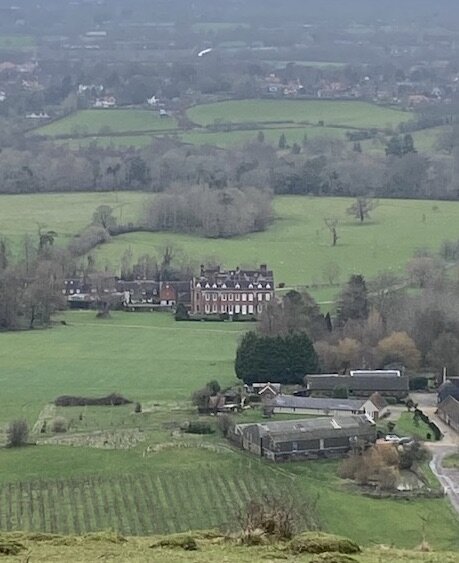A Circular Walk around the Downs near Burgess Hill
“They still spread their grassy surface to the sun as on that beautiful morning not, historically speaking, so very long ago; but the King and his fifteen thousand men, the horses, the bands of music, the princesses... how entirely they have they all passed and gone! - lying scattered about the world as military and other dust, some at Talvera, Albuera, Salamanca...and Waterloo, some in home churchyards; and a few small handfuls in royal vaults.”
Thomas Hardy is one of favourite novelists. His bucolic stories, bittersweet, often tragic, tend to be set in the rural parishes of olde Wessex - further to the west than my Sussex home. I’ve been rereading Hardy recently and by necessity, by design, I’ve also been walking the down-lands, woodlands and common lands around Burgess Hill.
Burgess Hill is a pretty nondescript town to be honest. I chose to live here years ago because of two reasons only - one, the houses prices were cheaper than Brighton or Worthing and, secondly, it has two mainline stations with a commute of less than an hour to London. But whilst it doesn’t ring any bells architecturally or culturally, it does sit in a sweet spot sheltering behind the ridges of the South Downs to the south - for example Wolstonbury Hill - and lying in the middle of the Sussex Weald.
So there’s a bucolic charm to found in the surrounding area; mighty oaks, coppiced beech, bluebells, ancient trails. It’s pretty. One of the nicest parts of the country. There’s a superficial certainty about the countryside - the seasons follow in a regular pattern, snowdrops are followed by crocuses, edged out by daffodils, carpet bombed by bluebells, superseded by roses. The common lands here detail brambles, ferns, grazing cows, dieback, desolation, and rebirth all in the correct order.
But to be alive is to be aware of change; sometimes good, often not.
The countryside around me in Sussex is sadly diminishing, year by year, acre by acre, at an increasing pace. New housing estates greedily gobble up those spaces between villages, tearing into the fabric of remembered country walks, disturbing those quiet places where once the busy calls of birds were all you could hear.
And so I frantically carve out new experiences; fashioning walks from footpaths researched or found, splicing together routes known or imagined to meld together that perfect creation, the circular walk. I now have plenty of these to occupy my enforced home captivity. They all tend to be variations on a theme, using and re-using certain pathways only to branch to the left, or through a woodland to the right, a hill in front, a bridge to the side. Constant reputation and adaption means I have options, sometimes taken randomly, often not.
Here is one such walk. It last about an hour or so at a brisk pace, two if you want to do it leisurely. There is no real hardship or rough terrain though the paths do tend to get muddy during the winter and so wellies (not walking boots) are advised at those times… But enough throat clearing, here is a brisk canter through an easy circular walk around the countryside of North Burgess Hill.
START: World’s End Car Park
Park in the recreation ground car park by the playground and head up Valebridge Road, ie away from the park and up the slight incline. After about 5 minutes you meet a small road leading right - Theobalds Road. We’ll be on that private lane for a little while so best to look around a bit. It’s quiet, populated by just the wealthy residents going back and forth and - in the early parts anyway - the ever present dog walkers. (An aside - there’s a lot of dogs around here. It seems fashionable to have more than one; two is a minimum. And are dogs getting smaller?)
Theobalds Road
As you walk up this quiet road, you’ll begin to notice notices pinned to fences and trees. They’re numbered 1 to 8 and detail a history trail. They’re quite informative - apparently Theobald’s Road is an ancient track - perhaps 2000 years old. It’s part of a trail that used to lead between Burgess Hill and Haywards Heath. The notices have a slightly autodidactic tone that hints at something unspoken. And then we have it… One of the notices attacks the ‘new’ houses to the right and the fact that the house-builders destroyed an ancient hedge. Yep, can’t agree more. Stop the bulldozers! Sign me up to a protest.
Of course, wandering further up the lane, where it’s quieter and the homes are older, one can’t help notice that farmers and residents in the older houses have also ‘changed’ the ancient hedges and installed modern fences and barbed wire. Mmm, nothing more bitter than a local dispute about hedges!
Anyway, follow the road for around a mile until, over on the right, you see a stile leading onto a narrow path that skirts a house and leftwards, some fields with horses. The trail leads downhill to another stile and into the woods. You’ll cross a bridge and climb back up to another stile that leads to what us country folk call, ‘a big field’. You’ll see what I mean. A vast area of greenness broken by two incomplete lines of oak trees. Walk around the field or head straight up the hill. There’s a gate at the top directly in front of the stile you’ve just climbed over and follow the track to the left.
You’ll find yourself on a driveway leading to a large house. But stop for a moment. Looking down you have great views over the downs and the distant hills. Worth the odd photo. And then, go through the kissing gate opposite and follow the trail downwards (houses on your left). This leads to a field which you’ll cross diagonally to the left and cross a stile. Follow the farm track at the bottom veering right. This leads - sometimes - to a field of cows. Walk along the right-edge of this field until it leads to the driveway of Ote Hall. This is a big Tudor Manor House that now does weddings. Worth a quick peep!
Head left down the road, passing the farm on your left until you get to Jane’s Road. Cross over and climb the stile directly opposite and head through this field keeping to the left until you reach the stile at the bottom. Turn left and follow the track along the edge of this field until it reaches a makeshift bridge over the stream. Cross this and turn right and, following this path, you’ll end up out of the countryside and on Manor Road. Turn right along Manor Road which very shortly brings you back to World’s End Recreation Ground.
You’ve made it! I hope you enjoyed those 10,00 steps!
As Burgess Hill residents, dog walkers and Nimbies might tell you, there are a thousand variants of this walk. Longer, shorter, less road, more woods, more common land. All true. But this is a logical - and easy - circle and that’s what I tend to look for when I come to a new area with no prior knowledge. For example, my walks centred around the Wey & Arun canal at Loxwood started small after reading about it on the internet. They have grown over the last year so I now incorporate together several bits and pieces of many walks to form an ever changing, ever expanding whole.
I started this piece with a quote from Hardy as he reflected on George III and his army parading on the Wessex Downs as they awaited to repel Napoleon and his vast invasion force. From then to now, Hardy was saying, they are all dead and gone. Use it or lose it people! We’re all in a parade where the flags won’t wave forever.
Come to Burgess Hill (said no one ever). Good walks, two stations. Waitrose.








